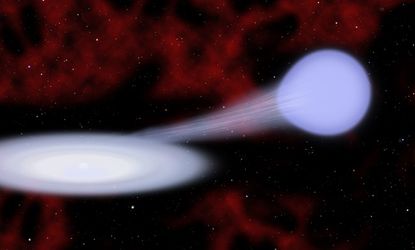Awww: Scientists discover a new breed of mini-supernovas
The supernovas' resulting explosions are so tiny they leave their binary white dwarf stars intact

The supernova is the most spectacular explosion of energy in all the cosmos, visible all the way to the bleeding edge of the universe. Astrophysicists can even use these brightly lit blasts to measure vast distances across dark galaxies.
A supernova's fireworks display, which can sometimes leave a light-gobbling black hole in its stead, typically comes in one of two flavors: Type Ia or Type II. A Type Ia supernova occurs in a binary star system, when a white dwarf star dies after absorbing too much mass from its companion star. When too much gas is siphoned off, the white dwarf momentarily goes quiet, before: Kaboom.
Type II, on the other hand, occurs when the core of a massive star 10 to 100 times the size of our own sun reaches the end of its life cycle and runs out of gas. Its tremendous mass then collapses on itself, releasing unfathomable amounts of nuclear energy into the universe. The supernova's epic collapse happens in just a few milliseconds.
Subscribe to The Week
Escape your echo chamber. Get the facts behind the news, plus analysis from multiple perspectives.

Sign up for The Week's Free Newsletters
From our morning news briefing to a weekly Good News Newsletter, get the best of The Week delivered directly to your inbox.
From our morning news briefing to a weekly Good News Newsletter, get the best of The Week delivered directly to your inbox.
And now, some scientists think there may be a third supernova class, one that admittedly pales in comparison to the first two. Astronomers from the Harvard-Smithsonian Center for Astrophysics have spotted a new kind of supernova with a blast so tiny (relatively speaking) they're calling it a Type Iax explosion. This "mini-supernova," says lead researcher Ryan Foley, is essentially "the runt of the supernova litter."
So what happens in this case? Unlike a Type Ia explosion, the companion star in a Type Iax supernova has already been stripped of its outer hydrogen layer, leaving behind mostly helium. Space.com explains:
The helium in the companion star's outer shell might undergo nuclear fusion, blasting a shock wave at the white dwarf that makes it detonate. On the other hand, all the helium the white dwarf accumulated from its companion star could alter the density and temperature of the white dwarf's interior, forcing carbon, oxygen and maybe helium within the star to fuse, triggering an explosion. [Space.com]
The resulting blast is much weaker than a Type Ia explosion, even leaving the white dwarf intact.
Astronomers have already observed 25 different examples of this phenomenon in the night sky. So why, then, are we just seeing them for the first time? Simply speaking, Type Iax explosions have been really hard to notice. "For more than a thousand years, humans have been observing supernovas," says Foley. "This whole time, this new class has been hiding in the shadows."
Sign up for Today's Best Articles in your inbox
A free daily email with the biggest news stories of the day – and the best features from TheWeek.com
The team estimates that the Large Synoptic Survey Telescope could reveal thousands of hard-to-spot Type Iax supernovas over the course of its lifetime. Poor things.
Create an account with the same email registered to your subscription to unlock access.
-
 'Horror stories of women having to carry nonviable fetuses'
'Horror stories of women having to carry nonviable fetuses'Instant Opinion Opinion, comment and editorials of the day
By Harold Maass, The Week US Published
-
 Haiti interim council, prime minister sworn in
Haiti interim council, prime minister sworn inSpeed Read Prime Minister Ariel Henry resigns amid surging gang violence
By Peter Weber, The Week US Published
-
 Today's political cartoons - April 26, 2024
Today's political cartoons - April 26, 2024Cartoons Friday's cartoons - teleprompter troubles, presidential immunity, and more
By The Week US Published